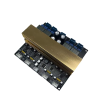firestart3r
Member
- Joined
- Aug 17, 2021
- Messages
- 50
- Likes
- 16
Hi all!
Does someone know how big is the 48V 5A power supply?
I can't find the dimensions on Fosi's website.
Thanks !
Does someone know how big is the 48V 5A power supply?
I can't find the dimensions on Fosi's website.
Thanks !

